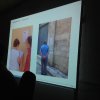
Mauro Bubbico. Graphic design: relationships, participation, sharing
The story of his graphic design. The passion for slowness, time, popular art, the cicada in the chest, the suspension, the room of the nicknames, the places, the poster, the teaching.
I want to talk about these things. They are often self-productions. Where there is substance, meaning and strength. They are works of this type. I am also a teacher. My teaching is based on what I do, at the ISIA in Urbino. I try to work for the culture and the economy.
I created over time a kind of a personal language, the peasant world. I hated it, but I have identified myself with this. And I recognize myself in the readings of the traditions. I take the kids to think about the size of the margin, of the village, of anything and the dust. From there can come a lot of inspiration. I find many people who follow me.
When I was younger I always began this way: with a passion for slowness.
With the passage of time going to Pesaro and that taking a whole day, I started to hate the lost time, but I started treasuring this slow way of doing things. When you work here in these contexts, and go out, there are some disappointments. Then I present the image of Kounellis, which transforms a gallery in a barn.
The old style was born from a kind of rejection of the Marshall Plan, Pop art waste. It goes back to the subordinate cultures. Kounellis refers to animals, placed in homes.
The commander Mark on candy wrap. Sottsass invites graphic designers to look at the candy wraps: look at the wraps, they tell stories. The ladies talk to each other outside the grocery and comment on the maps. This is my reference to popular art. This kind of art belongs to the oral tale: it is reused, modified and re-transmitted. Everyone can take action and change.
Costantino Nivola. In Manhattan, he visits an exhibition on Sardinian carpets. He asks to rest on one of those Sardinian rugs and feels the nostalgia of his land. He goes home and dies in the arms of his American wife.
Nivola. One supports the other. To communicate in this place.
I was introduced to this stereotype and have worked to change it. I designed it so many times a man and a woman. Every time I change them and do different things.
With the cicada in the chest is a new exhibition. A scribe. The graphics are a Zen exercise. This character is sitting and is a bit suspended.
I'm in this place of ten thousand inhabitants, in a suspended dimension. Because you can be a traveler to tell the world but you can also be a farmer.
The ristanza. He is the one who chooses to remain in place: I coined the suspension. I am, but I'm not there. I am, but I do not belong.
We need the customer, do not do it for ourselves. However, we have many ideas and often apply them working on the concept of participation. We develop in communities and we try to make it work in other better paid areas.
The room of nicknames. 600 sheets, A4 format. A total surprise. It's like being at the cemetery. A search of fun. The short names came out big. There was a chance to let the story of a new nickname or nicknames.
Maurice Sendak taught to fight fears. I mix the languages. I took his characters.
The event is not what people do. The event is the manifesto, which will continue to be talked about in time.
The poster works. Suddenly the subject of death. It must be in all stories. If you miss, you do not understand, it does not remain. People see each other again in the manifesto. Love is a theme that the living do not recognize and that you can only recognize in the afterlife.
What are the places
The book we did it with the studies that have been here for three months. We have experienced a wonderful time. We breathed graphic design. Then it was over.
Matera was told by Mario Cresci. Matera's signs and images. I came to the conclusion that it is not necessary to create new signs, but to explain the existing ones. Always drawing the same figures, changing them. If you build a nice project you do change, it is really a crime to leave it reduced to digital cover. It's a book of quotations from other books. It is a personal archive.
Mario Cresci. A beautiful and disturbing book, a beauty to other places. Houses that are lifeless. Places from which we escape. The book is divided into 4 parts. We have created more or less vague themes. Always two pages with opposing images. By analogy, we print the photos and see if they converse. We continued to talk about the city through fascination.
Captions are important. They are at the end, referring to other texts, according to an endless and encyclopedic history.
Handkerchief. The story of a Hungarian graphic designer that have worked before the birth of Bauhaus. He creates a poster: the red man. With a hammer in hand. Hercules. He used his companion as a model. It is such a beautiful poster that in the subsequent decades it is used by communist countries and has influenced the whole socialist imagination.
There is the myth of the seventies. Everything has been done in thos years. The instruments and materials to be used for production. In the recent years, many students have greatly admired this time in history, devoting themselves to a kind of antique research.
I noticed that this denounced a problem. The need to also experience them. But the time has changed. I suggested we make a magazine: a wall magazine that could explain and I am committed to print it. The project has moved forward. The boys have created a whole mechanism: blog, site, Facebook page, contacts. They have implemented the use of the magazine. It was nominated twice for several awards. They got an award from students and a jury award. It was a very important thing for this flag. Now the project goes ahead. The boys are seen to contact gay collectors who cultivate interest in printed gay motives.
The death of the poster is on the streets. Even the pork festival can be used to develop design.






































